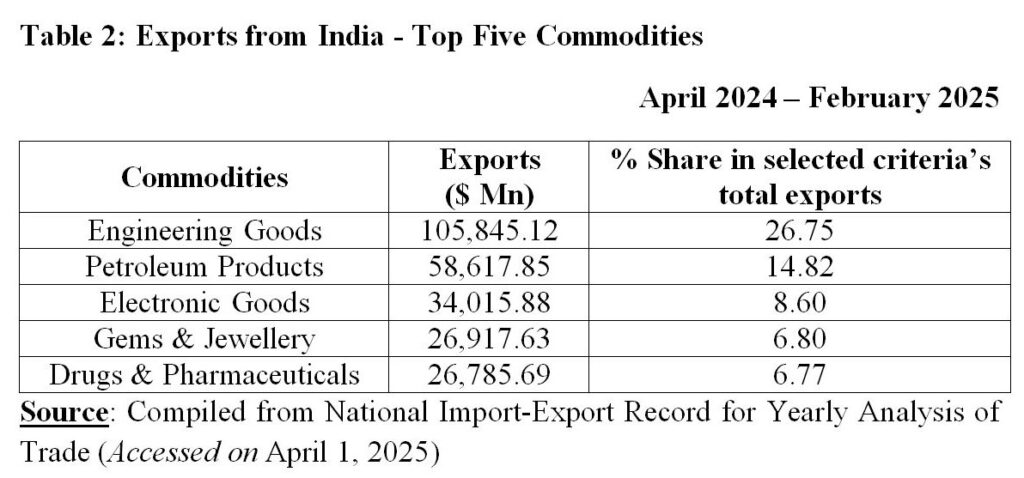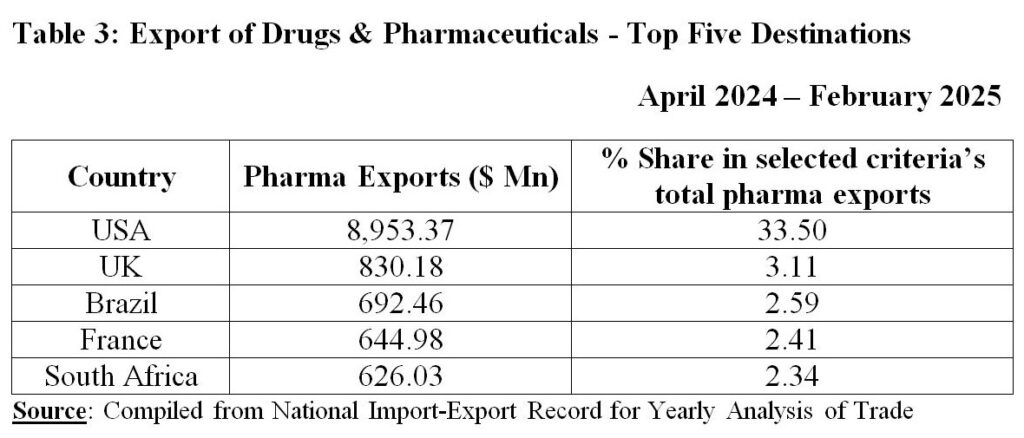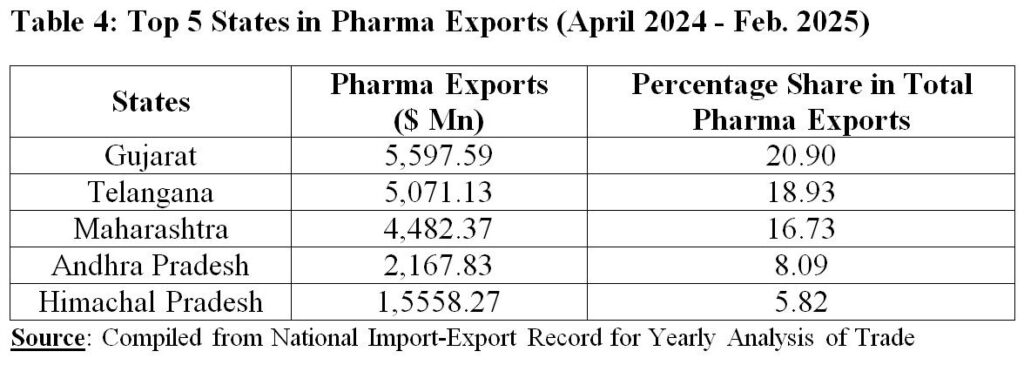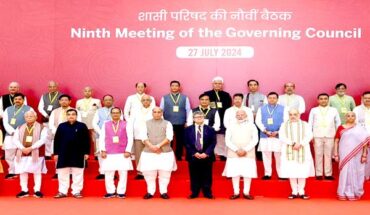In first eleven months of FY 2024-25, i.e., from April 2024 to February 2025, export of pharmaceuticals touched $26.72 Bn. In February 2025, India exported drugs & pharmaceuticals worth $2.47 Bn. Exports of Drugs & Pharmaceuticals were marginally lower in February 2025 as compared to exports of $2.58 Bn in January 2025 thereby registering a decline of 4.42 per cent. Exports for full FY25 are likely to cross $29.0 Bn, up from $27.85 Bn in FY24.
Growth in exports for FY25 is in line with the trend observed in previous five years. India has remained a net exporter of pharmaceuticals. Export of Pharmaceuticals stood at Rs. 2,19,439 Crore in FY24, up from Rs. 1,40,537 Crore in FY20.

Overall, export of pharmaceuticals revealed a positive trend in previous five years. Growth rate in exports of pharmaceuticals was lowest in 2021-22. Import of pharmaceuticals including bulk drugs, drug intermediates, etc. remain a concern. In 2019-2020, India had import of pharmaceuticals worth Rs. 40,139 Crore, which went up in 2020-2021 to Rs. 46,808 Crore. In 2021-22, the import of pharmaceuticals touched a new level of Rs. 60,060 Crore, the highest one in the period from 2020 to 2024. Import of pharmaceuticals declined to Rs. 56,391 Crore in FY 2022-23, but again in 2023-2024, trend got reversed due to increase in import of pharmaceuticals. In 2023-24, import of pharmaceuticals stood at Rs. 58,440 Crore.
Among commodities exported from India, Drugs & Pharmaceuticals figure among top 5 slots. Export of Drugs & Pharmaceuticals account for almost 7 per cent of India’s total merchandise exports by value for April 2024 to February 2025 period.

The USA market occupied the first place with exports worth $8,953.37 Mn during first 11 months of FY25 and formed about one-third of total export of drugs and pharmaceuticals from India as India exported drugs and pharmaceuticals worth $26,724.16 Mn (or $26.72 Bn) during this period. Because of this very reason, tariff in the USA remains a concern for Indian pharmaceutical companies.

Other major markets for Drugs & Pharma from India are Netherlands (2.09%), Canada (2.05%), Germany (2.02%), Russian Federation (1.89%), Belgium (1.81%), Nigeria (1.79%), Australia (1.58%), Philippines (1.49%), Kenya (1.45%), United Arab Emirates (1.29%), Mexico (1.10%), and China (1.09%).
Top five countries have 43.95 per cent share of Drugs & Pharmaceuticals’ exports from India. Top 10 markets collectively have 53.81 per cent share. Major share of exports to highly regulated markets remain a strength of Indian Pharmaceutical Industry. North American Free Trade Agreement (NAFTA comprising 3 countries) has 36.65 per cent share in total exports of Drugs & Pharmaceuticals followed by Europe (38 Countries/Territories) with 19.39 per cent share, Africa (48 Countries/Territories) with 13.15 per cent share, Latin American Countries (LAC) (43 Countries/Territories) with 6.79 per cent share, and Association of Southeast Asian Nations (ASEAN) (10 Countries/Territories) with 5.89 per cent share, are major Groupings forming major markets for Drugs & Pharmaceuticals from India.

Collectively, top five states had 70.47 per cent share in first 11 months’ exports of Drugs &Pharmaceuticals from India. Other States/Union Territories which have more than one per cent share in exports of Drugs & Pharmaceuticals include Madhya Pradesh (5.63%), Karnataka (5.28%), Goa (4.18%), Tamil Nadu (2.89%), Daman & Diu and Dadra & Nagar Haveli (2.67%), Punjab (1.76%), Rajasthan (1.35%), Haryana (1.32%), and Uttarakhand (1.24%).
Drug formulations and biologicals form a major proportion of pharmaceutical exports from India. Growth in exports of AYUSH and Herbal products remains a positive sign. In the beginning of FY 2024-25, India’s pharmaceutical exports were expected to touch $31 billion, due to various reasons. Shortage of drugs in the U.S. market, which occupies top slot for India’s export of pharmaceuticals, was cited as major reason in April 2024.
Closure of certain pharma plants in the USA was also positive for exports from India. In February 2023, Wockhardt had shut down its manufacturing facility at Morton Grove, Illinois in the USA. Wockhardt did it as a part of its business restructuring in the USA, and opted for third-party contract manufacturing to save about $12 million annually. In-house to Third-party contract manufacturing helped the company to lower fixed cost as the company was incurring a fixed cost of $25 million annually to operate the plant.
Jubilant Cadista Pharmaceuticals Inc., USA, the subsidiary of Jubilant Pharmova also decided to shut down the manufacturing operations of its solid dosage formulation facility at Salisbury, Maryland, USA in April 2024. Jubilant Cadista continued the sales and marketing operations for US market. This facility used to manufacture tablets and capsules for the US market with the capacity to serve almost 1.5 billion doses.
Closure of plants by Wockhardt and Jubilant Cadista are just two examples to point out the potential shift towards exports from India rather than manufacturing in the USA. Akorn Pharma became bankrupt and closed all US sites. The company also laid off entire workforce. These examples also showed the impact on supply of pharma products in the US market due to closures of manufacturing plants.
March 2025 figures on export of pharmaceutical products are not yet available but exports for full FY25 are likely to cross $29.0 Bn with an increase of just little more than $1 Bn over FY24 exports. Signals of decline in exports were visible for February and March 2025 due to the US reciprocal tariff threats. In February 2025, it was reported in media that the government was mulling incentives for exporters. Exporters anticipated announcement regarding allocation in the Export Promotion Mission which was announced in the recent Union Budget.
Exporters of pharmaceutical products expect that Trump administration will give preferential treatment to pharma exports as branded generics from India ultimately help the US consumers/patients to reduce their healthcare costs. Words of Commerce Minister Piyush Goyal convey the message in this context that councils (Pharmexcil with respect to pharmaceutical products) and industry associations need to come out of the protectionist mindset, and be bold and ready to deal with the world from a position of strength and self-confidence. Indian Pharmaceutical Industry is well-positioned to keep the momentum in exports of pharma products.
Dr. Anil Kumar Angrish- Associate Professor (Finance and Accounting),
Department of Pharmaceutical Management, NIPER S.A.S. Nagar (Mohali), Punjab
Disclaimer: Views are personal and do not represent the views of the Institute.






